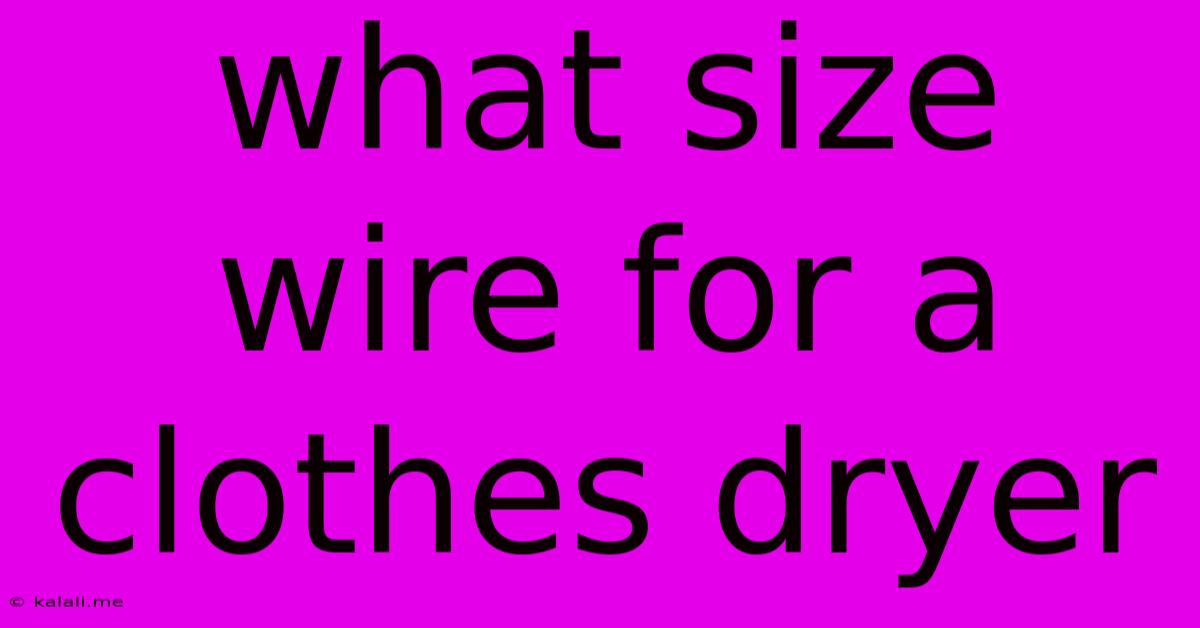What Size Wire For A Clothes Dryer
Kalali
Jun 07, 2025 · 3 min read

Table of Contents
What Size Wire for a Clothes Dryer? A Comprehensive Guide
Choosing the right wire gauge for your clothes dryer is crucial for safety and efficiency. Using a wire that's too thin can lead to overheating, fire hazards, and potential damage to your appliance. This guide will walk you through determining the correct wire size for your specific dryer setup, ensuring both safety and optimal performance. Understanding amperage and voltage is key to this process.
Understanding Amperage and Voltage Requirements
Before you even think about wire gauge, you need to know your dryer's electrical requirements. This information is usually found on a sticker located on the dryer itself, often on the back or inside the door. Look for the voltage (typically 120V or 240V) and the amperage (measured in amps, or A). The amperage rating dictates the amount of current your dryer draws, which directly influences the wire size needed. A higher amperage demands a thicker, lower-gauge wire.
Matching Wire Gauge to Dryer Amperage
The National Electrical Code (NEC) provides guidelines for wire sizing based on amperage and the length of the run. Here's a simplified breakdown, but always consult a qualified electrician if you're unsure:
-
High Amperage Dryers (typically 30 amps or higher): These dryers require thicker wires, usually 10 AWG or 8 AWG copper wire. This is because they draw significantly more power and require a lower resistance wire to handle the higher current. These are usually 240V dryers.
-
Lower Amperage Dryers (typically less than 30 amps): These dryers may use 12 AWG or 14 AWG copper wire, although 12 AWG is generally recommended for safety and to avoid voltage drop. These are often 120V dryers, but even 240V dryers might fall in this category if they have a lower amperage requirement.
Important Note: Copper wire is the standard for household wiring due to its superior conductivity. Aluminum wire is less commonly used for dryers due to higher resistance and safety concerns.
Calculating Wire Length and Voltage Drop
The length of the wire run from your electrical panel to the dryer also affects the appropriate wire gauge. Longer runs necessitate thicker wires to minimize voltage drop, which can lead to reduced dryer performance and potential overheating. While precise calculations can get complex, using a larger gauge than strictly required for the amperage is a sensible safety margin, especially for longer runs. A slightly larger wire gauge will compensate for potential voltage drop over distance.
Other Considerations: Outlet and Breaker
Remember, the wire gauge isn't the only factor. You'll also need to ensure your outlet and circuit breaker are compatible with your dryer's electrical requirements. A 30-amp dryer needs a 30-amp breaker and a NEMA 14-30R receptacle (for 240V). Always match the amperage of the breaker to the dryer’s requirements. Mismatched components create safety risks.
When to Call a Professional
While this guide provides helpful information, electrical work can be dangerous. If you're uncomfortable working with electricity, always consult a qualified electrician. They can assess your specific situation, determine the correct wire gauge and ensure everything is installed safely and correctly, preventing potential hazards and fire risks. Improper wiring is a significant fire hazard.
By following these guidelines and prioritizing safety, you can ensure your clothes dryer is properly wired and operates efficiently for years to come. Remember, safety should always be your top priority when working with electrical appliances.
Latest Posts
Latest Posts
-
Do You Need An Id For A Bus Ticket
Jun 07, 2025
-
How Much Caffeine In Cold Brew Coffee
Jun 07, 2025
-
Best Cheapest Non Box Store Mountain Bike
Jun 07, 2025
-
Is Dissolving Sugar In Water A Chemical Change
Jun 07, 2025
-
How To Say You Re Welcome In French Language
Jun 07, 2025
Related Post
Thank you for visiting our website which covers about What Size Wire For A Clothes Dryer . We hope the information provided has been useful to you. Feel free to contact us if you have any questions or need further assistance. See you next time and don't miss to bookmark.